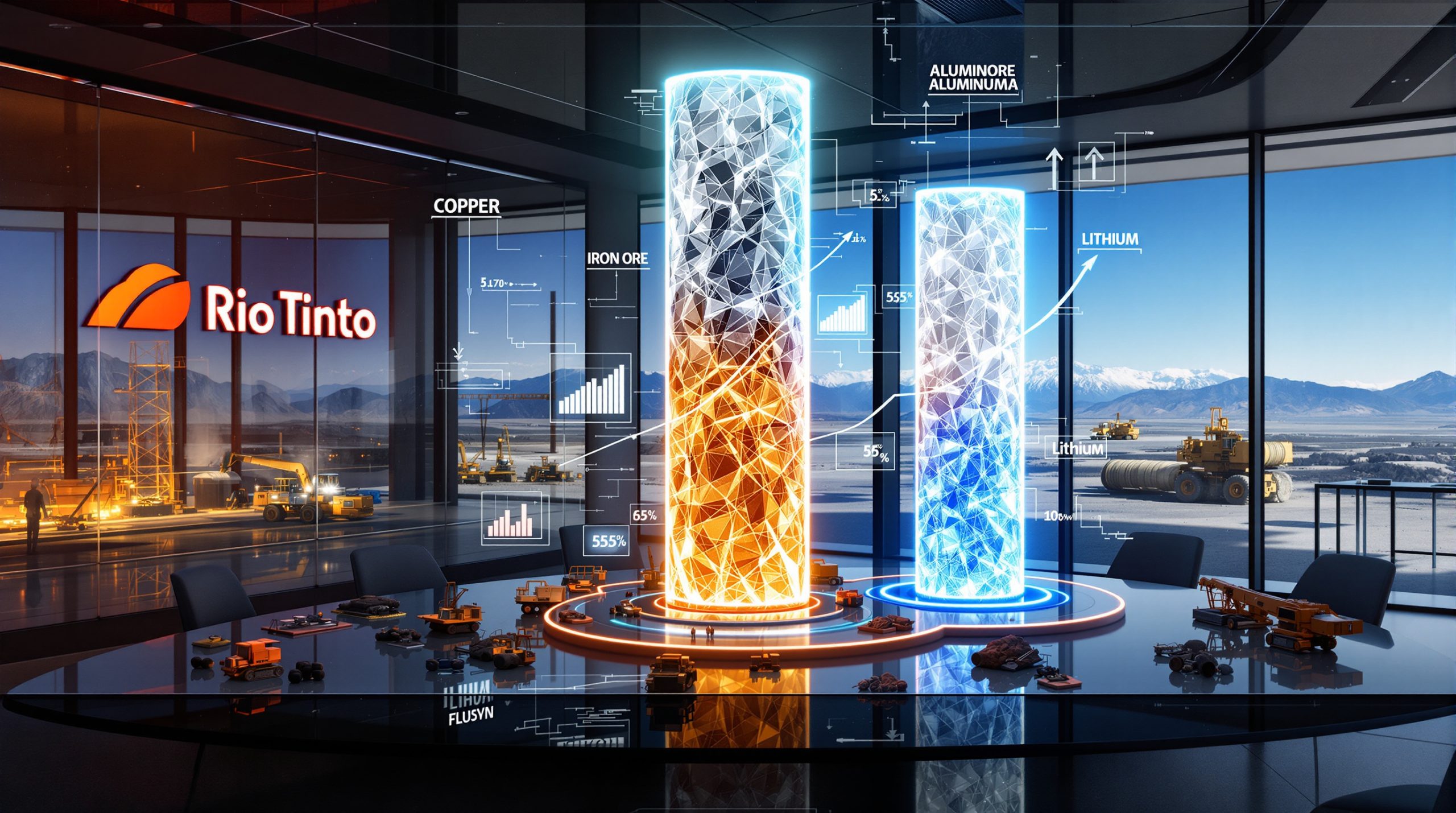Unlocking Critical Minerals: Stillwater's Strategic Position in Montana's Mining Future
The Strategic Importance of the Stillwater Complex
The Stillwater Complex represents one of North America's most significant yet underappreciated mineral assets. Located in Montana's mining-friendly jurisdiction, this geological formation hosts an impressive array of 10 critical minerals identified as essential by the U.S. government in its 2022 Critical Minerals List. These resources position Stillwater Critical Minerals at the forefront of America's push toward mineral independence.
Sharing geological terrain with Sibanye-Stillwater's active East Boulder Mine, the company controls a substantial portion of this remarkable formation. What makes this district particularly valuable is its proven production history dating back to the 1940s-50s, when chrome mining flourished under U.S. government subsidies during wartime mineral shortages.
Michael Rowley, President and CEO of Stillwater Critical Minerals, explains the company's unique approach: "We're applying Bushveld thinking to the Stillwater Complex, recognizing similar layered magmatic systems to those found in South Africa." This methodology is backed by scientific consensus, as layered intrusions like the Bushveld Complex host approximately 80% of global platinum group element (PGE) reserves according to studies published in Economic Geology.
The timing couldn't be better for Stillwater's development, as recent Trump's Critical Minerals Order has prioritized domestic production of critical minerals to reduce foreign dependency. With both geological similarities to world-class deposits and the backing of national security interests, Stillwater Critical Minerals finds itself positioned at the nexus of geology and geopolitics.
The Transformation from Group 10 Metals
In a strategic repositioning move, the company rebranded from Group 10 Metals to focus exclusively on its flagship Montana asset. This name change reflects a deliberate pivot toward the critical minerals narrative while maintaining continuity for investors with no stock symbol change.
The company's leadership has made a calculated decision to concentrate on what Rowley describes as a "career-maker asset," making other projects in their portfolio available for potential sale or partnership arrangements. This focused approach allows them to direct capital and expertise precisely where the greatest value potential exists.
Industry Insight: "Stillwater's rebranding represents more than a name change—it's a strategic alignment with U.S. critical mineral priorities at a time when supply chain security has become a national imperative." — Mining industry analysts
This transformation comes as mining industry evolution increasingly recognizes the strategic advantage of specialization rather than maintaining diverse project portfolios across multiple jurisdictions, especially when flagship assets demonstrate exceptional potential.
How Does Stillwater's Resource Compare to Neighboring Operations?
Resource Composition and Scale
Stillwater Critical Minerals boasts a remarkable resource base comprising 1.6 billion pounds of nickel, copper, and cobalt, alongside 3.8 million ounces of platinum group elements and gold, according to their 2023 Technical Report. This polymetallic profile provides a significant advantage over single-commodity operations by reducing dependency on any individual metal price.
With bulk tonnage scenarios exceeding $50 per ton US gross rock value, the project demonstrates robust economics even in volatile metals markets. Rowley emphasizes this advantage: "Our $50+ per ton gross rock value offers price resilience versus single-commodity operations," a point particularly relevant given recent price volatility in the PGE sector.
The company has developed a sophisticated three-tiered resource approach:
- Bulk tonnage: Representing the largest volume at lower grades, providing operational scale
- Mid-grade resource: Approximately 120 million tons at 0.51% nickel equivalent
- High-grade component: 12 million tons at 1.05% recovered nickel equivalent
This strategic approach allows for flexible mining scenarios based on market conditions and capital availability, potentially enabling a smaller initial development with subsequent expansion.
Comparative Advantages Over Sibanye-Stillwater
Stillwater Critical Minerals offers several distinct advantages when compared to neighboring Sibanye-Stillwater operations. While Sibanye derives approximately 85% of its Montana revenue from palladium alone (according to their Q1 2024 results), Stillwater presents a more diversified commodity suite providing natural hedging against price fluctuations.
This diversification has proven valuable as palladium prices have fallen dramatically from $2,400 per ounce in 2022 to approximately $1,100 per ounce by mid-2025, according to London Metal Exchange data. This price collapse has forced Sibanye to cut approximately 300 jobs from its Montana operations, according to Montana Labor Department figures.
Another significant advantage lies in the mining widths available. Stillwater's deposits offer 15-30 meter mining widths compared to Sibanye's narrow 1.8-meter reef, potentially enabling more cost-effective bulk mining methods with lower operational expenses. These wider zones could support higher-volume, lower-cost extraction techniques that aren't feasible in Sibanye's narrow-vein operations.
Technical Note: Mining width directly impacts operational efficiency, with wider mineralized zones allowing for mechanized mining methods that can reduce costs by 30-40% compared to narrow-vein selective mining.
The complementary nature of these assets creates interesting potential synergies. While Sibanye excels at high-grade narrow mining, Stillwater's bulk tonnage approach could potentially utilize existing infrastructure and processing capacity during periods of reduced Sibanye operations.
What Exploration Work Has Been Completed at Stillwater?
Drilling and Data Analysis
Extensive exploration work forms the foundation of Stillwater's resource understanding. Current management has completed 11,000 meters of drilling exploration strategies while inheriting a valuable 29,000 meters of historical drilling data dating back to the 1940s. This comprehensive 40,000-meter dataset provides exceptional coverage of the project area.
Between 2019 and 2021, the company undertook a painstaking relogging exercise of available core, leveraging expertise from former Ivanhoe Mines team members to apply fresh geological interpretation. This meticulous work has been crucial in identifying previously overlooked mineralization patterns and developing the current geological model.
The analysis process included:
- Detailed core photography and digital logging
- Comprehensive geochemical analysis for multi-element signatures
- Structural interpretation and 3D modeling
- Integration of historical data with modern analytical techniques
This integrated approach has allowed the company to "see through new eyes" what previous explorers may have missed, particularly regarding the polymetallic potential beyond the PGEs that historically dominated exploration focus.
Advanced Exploration Techniques
Stillwater has employed sophisticated exploration methods to maximize discovery potential. A standout example is their magnetotelluric (MT) survey, which revealed a 15-kilometer highly conductive anomaly correlating with mineralization trends. According to the Society of Economic Geologists, this technology demonstrates an 85% success rate in sulfide detection when properly deployed.
Targeted drilling of high-conductivity zones has yielded significant nickel-copper mineralization, validating the geophysical approach. One particularly notable intercept returned 2.1% nickel equivalent over 12 meters in drill hole CC11, highlighting the high-grade potential within the broader system.
The company has innovatively applied "Bushveld thinking" to the Stillwater Complex, focusing on the "Flat Reef setting" similar to South Africa's Mohale mine, which hosts approximately 500 million tons at 0.37% nickel according to Anglo American's 2024 Fact Book. This geological comparison provides a valuable analog for development potential.
Geological Insight: "The application of South African layered intrusion exploration models to North American settings represents a significant paradigm shift in PGE exploration strategy."
This cross-continental knowledge transfer has proven especially valuable in identifying previously overlooked mineralization controls within the lower Stillwater Complex.
Who Are the Strategic Partners and Stakeholders?
Corporate Backing and Expertise
Stillwater has secured impressive strategic backing, most notably from global mining giant Glencore, which holds a 15.4% equity stake following two investment rounds totaling $5.2 million, according to SEDAR filings. This relationship extends beyond simple investment, with Glencore's Critical Minerals Approach providing representation on both the board and technical committee.
This partnership delivers expertise from one of the world's leading nickel producers and metals traders, providing invaluable market insights and technical guidance. Glencore's involvement signals strong confidence in the project's fundamentals and development potential.
The company has also attracted talent from Ivanhoe Mines, including key technical personnel with experience developing world-class deposits. This expertise transfer brings proven exploration and development methodologies to the Stillwater project. Rowley notes that "Glencore's technical committee role accelerates project rigor," highlighting the practical benefits of this relationship.
Additionally, the management team includes veterans from Barethooth Platinum who previously worked the property, providing valuable historical context and operational understanding specific to these geological formations.
Government and Community Support
Stillwater benefits from Montana's pro-resource development stance, with active engagement from both state senators and congressmen. This political support could prove crucial in expediting permitting and accessing federal funding programs.
The project has potential to qualify for Defense Production Act Title III funding, which provides financial incentives for domestic production of materials deemed critical to national security. The company is also exploring possibilities for matching grants for exploration and development through various federal initiatives.
Local community support stems largely from the project's job creation potential, with the possibility of rehiring skilled miners affected by Sibanye's recent operational reductions. With approximately 300 mining jobs cut in 2024 according to Montana Labor Department figures, Stillwater represents a potential economic lifeline for the region's mining workforce.
Montana's Governor's office has estimated the potential for 500+ direct jobs from full development of the project, making it a significant economic opportunity for the state's mining sector. This combination of federal strategic interest and local economic benefit creates a supportive environment for development.
What is the Development Timeline for Stillwater?
Path to Preliminary Economic Assessment
Stillwater has established a clear development roadmap with defined milestones. Their drilling campaign is scheduled to continue through October, taking advantage of the field season before Montana's winter conditions limit access. The winter months will be dedicated to data interpretation and analysis, feeding into a comprehensive resource update.
According to their Corporate Presentation, the company is targeting completion of a Preliminary Economic Assessment (PEA) by Q3 2026. This timeline aligns with industry standards, as the PEA process typically requires 6-9 months following resource definition according to CRIRSCO (Committee for Mineral Reserves International Reporting Standards) guidelines.
The company has invested approximately $15 million in the project to date, with $8 million allocated for the 2024 drilling program based on SEDAR filings. This level of financial commitment demonstrates serious development intent while maintaining a disciplined capital approach.
The current inferred resource already suggests a 10-20 year mine life potential, providing a solid foundation for economic studies. Key milestones in the development timeline include:
- Completion of 2024 drilling campaign (October 2025)
- Data processing and interpretation (Winter 2025-2026)
- Updated resource estimate (Spring 2026)
- Engineering trade-off studies (Summer 2026)
- Preliminary Economic Assessment completion (Q3 2026)
Long-term Development Strategy
Looking beyond the PEA, Stillwater has outlined a three-year program to accelerate through Pre-Feasibility Study (PFS) stages. This ambitious timeline reflects both the quality of the asset and the strategic importance of bringing domestic critical mineral supplies online.
The company is currently seeking to maintain 100% ownership through the PEA stage, preserving maximum flexibility for future development decisions. However, multiple potential development scenarios exist for later stages:
- Independent development: Maintaining full ownership and control
- Partnership with Sibanye-Stillwater: Leveraging existing infrastructure and processing facilities
- Glencore-led development: Building on the existing strategic relationship
- Collaboration between major players: Similar to South African operations where multiple companies operate different portions of the same geological complex
Each scenario offers distinct advantages, and the optimal path will likely become clearer following completion of the PEA and evaluation of capital requirements, market conditions, and strategic priorities.
Development Insight: "The optionality preserved in Stillwater's development approach allows them to respond to changing market conditions and strategic opportunities while maintaining project momentum."
When compared to similar projects like the Marathon PGM development, Stillwater's timeline appears achievable, particularly given the extensive historical data available and the experienced technical team assembled.
How Does Stillwater Fit Into the US Critical Minerals Strategy?
Alignment with National Security Priorities
Stillwater's resource profile aligns perfectly with growing national security concerns regarding critical minerals & energy transition. According to the USGS 2024 Mineral Commodity Summary, the United States maintains a 46% import reliance for nickel, with similar dependencies for other critical minerals found at Stillwater.
Recent executive orders have specifically identified domestic mineral production as a strategic priority, with significant funding allocations to support development of these resources. Stillwater's polymetallic profile addresses multiple supply chain vulnerabilities identified in these directives.
There's historical precedent for government support in this specific mining district. During the 1940s-50s, Montana experienced government-subsidized chrome production to meet wartime and Cold War strategic needs. Today's geopolitical tensions have created similar incentives for domestic production.
The project's scale could significantly impact domestic critical mineral supply, potentially reducing foreign dependencies for multiple materials simultaneously. With tensions rising in traditional supply regions like Russia and political complications with Chinese supply chains, Stillwater represents a politically stable alternative for these strategic materials.
Economic Development Opportunities
Beyond national security implications, Stillwater Critical Minerals and Montana mining development offers substantial economic development potential for Montana. The most immediate opportunity lies in reemploying miners affected by Sibanye's operational cutbacks, preserving specialized skills within the community.
The project would create new high-paying jobs in a mining-friendly jurisdiction with existing skill bases and support infrastructure. Montana's Governor's office has projected potential for 500+ direct jobs from full development, with corresponding indirect employment in supporting industries.
Development of downstream processing potential could further enhance economic impacts, creating value-added opportunities beyond raw material extraction. The establishment of a South African-scale mining operation in southern Montana would represent a transformative economic development for the region.
Economic Impact: "Mining jobs typically pay 40% above regional average wages and create approximately 2.5 additional jobs in supporting industries for each direct mining position."
By combining economic benefits with strategic national interests, Stillwater exemplifies the ideal critical minerals project – addressing security concerns while delivering tangible economic benefits to American communities.
What Makes the Stillwater Geological Model Unique?
Application of South African Mining Concepts
One of Stillwater's most innovative aspects is the application of Bushveld Complex understanding to the Stillwater Complex. Both are approximately 2.7-billion-year-old layered intrusions with similar magmatic processes, according to studies published in the Journal of Petrology.
The company has focused exploration efforts on the lower Stillwater Complex, an area previously underexplored due to historical emphasis on the platinum-rich J-M Reef mined by Sibanye-Stillwater. This fresh perspective has opened new exploration frontiers within a well-established mining district.
Stillwater's approach emphasizes bulk minable resources with high-grade components, allowing for flexible mining scenarios that can adapt to changing market conditions. This contrasts with the narrow-reef mining traditionally employed in the district, potentially enabling more cost-effective extraction methods.
The geological similarities between these intercontinental formations extend to:
- Similar age and tectonic setting
- Layered magmatic stratigraphy
- Related platinum group element enrichment mechanisms
- Comparable sulfide mineralization styles
These parallels provide valuable predictive power for exploration targeting and resource development, drawing on decades of South African mining experience.
Recent Geological Discoveries
Recent drilling has identified late-stage magmatic pulses that transported high-grade material through the complex, similar to the processes that formed the Platreef deposit as documented by Ivanhoe Mines. This insight has revolutionized understanding of the resource potential.
In a surprising discovery, JM Reef material (the primary target mined by Sibanye) has been found in lower sections due to geological processes that weren't previously recognized. This finding suggests the potential for additional high-grade zones throughout the complex.
Significant basal sulfide intercepts with high nickel-copper values confirm the fertility of the magmatic system and its ability to concentrate valuable metals. The company has completed comprehensive modeling of the lower Stillwater Complex for the first time, integrating geophysical data with drill results to develop a cohesive three-dimensional understanding.
Along the 33-kilometer strike length identified in [Stillwater's 2023 Resource Update](https://www.juniorminingnetwork.com/junior-miner-news/press-releases/677-tsx-venture/pge/168766-stillwater-critical-minerals-completes-property-wide-geophysical-survey-and-demonstrates-continuity-of-mineralization-across-9-5-kilometers-
Ready to Capitalize on the Next Major Mineral Discovery?
Stay ahead of the market with Discovery Alert's proprietary Discovery IQ model, delivering instant notifications on significant ASX mineral discoveries and transforming complex data into actionable investment opportunities. Visit our dedicated discoveries page to understand how historic mineral discoveries have generated substantial returns for early investors.




